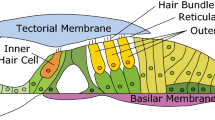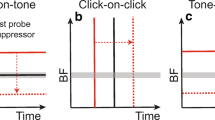Abstract
The recent observations of sharply-tuned basilar membrane motion and the existence of cochlear acoustic emissions provide evidence that the cochlea is an active mechanical system, capable of generating mechanical vibrations. A model of cochlear mechanics is presented in this paper to support the hypothesis that the primary function of mechanical generators in the cochlea is to amplify displacements of the basilar membrane at sound levels near the threshold of hearing. Some numerical solutions of this model show basilar membrane displacement amplitudes of about 1 angstrom for sound pressures at the eardrum of 0 dB SPL (20 µPa). The rate of energy flow out of the basilar membrane into the cochlear fluid due to the cochlear amplifier is often more than 40 dB greater than the rate of energy flow into the cochlea from the stapes. The action of the cochlear amplifier in this model may be interpreted as a piezoelectric effect which provides a delayed positive feedback to basilar membrane motion.
Access this chapter
Tax calculation will be finalised at checkout
Purchases are for personal use only
Preview
Unable to display preview. Download preview PDF.
Similar content being viewed by others
References
Allen, J.B. (1983). Magnitude and phase frequency response to single tones in the auditory nerve, Journal of the Acoustical Society of America, (in press).
de Boer, E. (1983). On active and passive cochlear models — toward a generalized analysis, Journal of the Acoustical Society of America (in press).
Davis, H. (1981). The second filter is real, but how does it work? American Journal of Otolaryngology 2, 153–158.
Davis, H. (1983). An active process in cochlear mechanics, Hearing Research 9, 79–90.
Kim, D.O., Neely, S.T., Molnar, C.E., and Matthews, J.W. (1980). An active cochlear model with negative damping in the cochlear partition: Comparison with Rhode’s ante-and post-mortem observations. In: Psychological, Physiological, and Behavioral Studies in Hearing, edited by G. van den Brink and F.A. Bilsen (Delft University Press, Delft, the Netherlands), pp. 7–14.
Liberman, M.C. (1982). The cochlear frequency map for the cat: Labeling auditory-nerve fibers of known characteristic frequency, Journal of the Acoustical Society of America 72, 1441–1449.
Lynch, T.J., Nedselnitsky, V., and Peake, W.T. (1982). Input impedance of the cochlea in cat, Journal of the Acoustical Society of America 72, 108–130.
Matthews, J.W. (1980). Mechanical Modeling of Nonlinear Phenomena Observed in the Peripheral Auditory System. Doctoral dissertation (Washington University, St. Louis, Missouri).
Neely, S.T. (1980). Finite difference solution of a two-dimensional mathematical model of the cochlea, Journal of the Acoustical Society of America 69, 1386–1393.
Neely, S.T. (1981). Fourth-order Partition Mechanics for a Two-dimensional Cochlear Model. Doctoral dissertation, (Washington University, St. Louis, Missouri).
Neely, S.T., and Kim, D.O. (1983). An active cochlear model shows sharp tuning and high sensitivity, Hearing Research (in press).
Rhode, W.S. (1978). Some observations on cochlear mechanics, Journal of the Acoustical Society of America 64, 158–176.
Sellick, P.M., Pattuzzi, R., and Johnstone, B.M. (1982). Measurement of basilar membrane motion in the guinea pig using the Mössbauer technique. Journal of the Acoustical Society of America 72, 131–141.
Author information
Authors and Affiliations
Editor information
Editors and Affiliations
Rights and permissions
Copyright information
© 1983 Delft University Press, The Netherlands
About this paper
Cite this paper
Neely, S.T. (1983). The Cochlear Amplifier. In: de Boer, E., Viergever, M.A. (eds) Mechanics of Hearing. Springer, Dordrecht. https://doi.org/10.1007/978-94-009-6911-7_13
Download citation
DOI: https://doi.org/10.1007/978-94-009-6911-7_13
Publisher Name: Springer, Dordrecht
Print ISBN: 978-94-009-6913-1
Online ISBN: 978-94-009-6911-7
eBook Packages: Springer Book Archive




